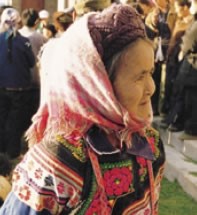Laka in China

Photo Source:
Copyrighted © 2026
Operation China, Asia Harvest All rights reserved. Used with permission |
Send Joshua Project a map of this people group.
|
| People Name: | Laka |
| Country: | China |
| 10/40 Window: | Yes |
| Population: | 7,900 |
| World Population: | 7,900 |
| Primary Language: | Language unknown |
| Primary Religion: | Christianity |
| Christian Adherents: | 41.00 % |
| Evangelicals: | 32.52 % |
| Scripture: | Unspecified |
| Ministry Resources: | No |
| Jesus Film: | No |
| Audio Recordings: | No |
| People Cluster: | Tibeto-Burman, other |
| Affinity Bloc: | Tibetan-Himalayan Peoples |
| Progress Level: |
|
Introduction / History
The Laka are a subgroup of the Naluo, who are officially considered a subgroup of the Yi. The name "Laka" may originate from the Chinese term laogan, "old workers," or a Yi term meaning "artisan." In the early 1900s, the Laka may have been workers who helped construct the railroad in northern Yunnan. Samuel Clarke unflatteringly described them as "very drunken and immoral." The Laka are often confused with the Lakkia people of the Guangxi Zhuang Autonomous Region, a Yao group who are also sometimes called Laka.
The Laka are part of the splintering of people groups that has taken place in the mountains of southwest China over the past 2,000 years. One source states that the main difference between the Laka and the Naluo is that the Laka were slaves and serfs of the Nasu while the Naluo were not. This historical and social separation has created a distinct self-identity among the two groups today.
What Are Their Lives Like?
The Laka earn their livelihood from the bounty of the Yangtze River. This part of the Yangtze contains a nearly extinct breed of albino dolphins found nowhere else in the world.
What Are Their Beliefs?
The Laka were traditionally animists and polytheists until they were converted by missionaries prior to 1949. Today many Laka are nonreligious and have adopted many of the customs of the Han Chinese people in the area.
Mission outreach to the Laka commenced in the early 1900s. In 1908, it was reported that "the work among the Laka is now being consolidated by the appointment of Mr. Metcalf as their own missionary." The Gospel of Mark was translated into the Laka language using the Pollard script and distributed between 1912 and 1936. Most Laka are mixed in with Eastern Lipo communities and few outsiders know of their existence. Missiologist Ralph Covell has stated, "The name Laka people is repeatedly mentioned in missionary literature about Yunnan. Always it appears with the sorry refrain that although the Laka wanted to believe, no one was available to go to them, either to evangelize or disciple."
What Are Their Needs?
With a large percentage of Christians, the Laka need to take the fragrance of Christ to the unsaved.
Prayer Points
Pray for Laka disciples to make more disciples.
Pray for Laka Christians to pray and go to the lost peoples of China.
Pray for the Laka to abundantly bless Lagou families with his abundant grace, mercy and love.
Pray for the authority of Christ to bind hindering spiritual forces to lead them from darkness to light.